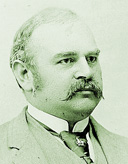Richard Zschille
Louis Moritz Richard Zschille (born March 16, 1847 in Großenhain ; † July 9, 1903 in Klotzsche near Dresden ) was a German cloth manufacturer, art collector and donor in Großenhain.
Live and act
Richard Zschille came as the son of the Großenhain cloth manufacturer Ernst Moritz Louis Zschille (1815–1867) and his wife Ernestine Luise, nee. Hellwig (1825–1908) to the world. He grew up as the eldest child together with his six sisters and his younger brother in Grossenhain. In 1872 Richard Zschille and his cousin took over the management of the father's business. In the same year, Zschille married Ida Hartmann (1850–1933), daughter of the Chemnitz machine manufacturer and railway pioneer Richard Hartmann .
The entrepreneur had a great passion for valuable works of art and historical objects from an early age. He had his villa (“Zschille Villa”) furnished with art treasures from all over the world. For example, a Gothic gate from the 15th century, a fountain from the 16th century and a column from Pompeii were built into the villa . His collection included furniture, porcelain, thousands of weapons, glass, ceramic, ivory, metal, and textiles. His cutlery collection was the most important private collection of its kind at the time.
Richard Zschille was a member of the "Council of the City of Grossenhain" from 1887 to 1898. In 1898 he designed the new Großenhain city coat of arms and sponsored various publications. Richard Zschille published works with archaeologist Richard Forrer on stirrups and spurs and a chronicle of his cloth factory. In 1892 he became a member of the Royal Saxon Antiquities Association of the Art History Society in Berlin.
On the occasion of Martin Luther's 400th birthday in 1883, his family donated the “Easter window” for the Großenhainer Marienkirche and also financed the restoration work in the church a few years later.
In 1893 Zschille exhibited part of his collection at the world exhibition in Chicago. There he was also a member of the jury for the Saxon cloth industry group. King Albert of Saxony awarded Zschille the Knight's Cross First Class of the Order of Albrecht .
In the mid-1890s, the profit situation of his cloth factory deteriorated and Richard Zschille got increasingly into financial difficulties. From 1897 he was forced to auction parts of his collection and in 1900 bankruptcy proceedings were opened against his assets. A year later Richard Zschille was forced to sell his villa. He moved to Klotzsche near Dresden, where he worked as an illustrator. His Grossenhain cloth factory "Gebrüder Zschille" was converted into a stock corporation, in which the Zschille family was no longer involved. Richard Zschille ended his life as a financially completely ruined and broken man by suicide, but the official cause of death was "stroke".
Richard Zschille's collection has largely been dissolved, but some important parts of the museum have been acquired by public museums. For example, the collection of bronze helmets is on display in the Museum of Prehistory and Early History in Berlin .
literature
- Frauke Hellwig: Richard Zschille (1847–1903) - Rise and Fall of an Art Collector , activ Verlag, 2006 ISBN 978-3-9811358-0-0
- Otto von Falke: Richard Zschille Collection: Catalog of Italian majolica , Hiersemann, 1899
- Robert Forrer , Richard Zschille: The weapons collection of the city councilor Richard Zschille in Grossenhain Saxony , 236 plates in collotype with text by R. Forrer. (Vol. 1.2.), 1894
- Jens Schulze-Forster: "Ceramics of the Middle Ages and the Renaissance in the Zschille Collection, Großenhain". In: R. Smolnik (Ed.), Keramik in Mitteldeutschland. State of research and perspectives. 41st International Pottery Symposium of the Working Group for Ceramic Research, State Office for Archeology Dresden 2012, pp. 289–298.
Web links
- Literature by and about Richard Zschille in the catalog of the German National Library
- Roman Töppel: Zschille, Louis Moritz Richard . In: Institute for Saxon History and Folklore (Ed.): Saxon Biography .
Individual evidence
- ↑ Leibniz Institute for Regional Geography and Saxon Academy of Sciences in Leipzig: Grossenhainer Pflege , from Landscapes in Germany, Values of the German Homeland , Volume 70, Böhlau Verlag Köln Weimar Vienna, 2008, p. 365 ISBN 978-3-412-09706- 6th
- ^ Roman Töppel: Zschille, Louis Moritz Richard . In: Institute for Saxon History and Folklore (Ed.): Saxon Biography .
| personal data | |
|---|---|
| SURNAME | Zschille, Richard |
| ALTERNATIVE NAMES | Zschille, Louis Moritz Richard |
| BRIEF DESCRIPTION | German cloth manufacturer, art collector and donor in Großenhain |
| DATE OF BIRTH | March 16, 1847 |
| PLACE OF BIRTH | Grossenhain |
| DATE OF DEATH | July 9, 1903 |
| Place of death | Klotzsche |


